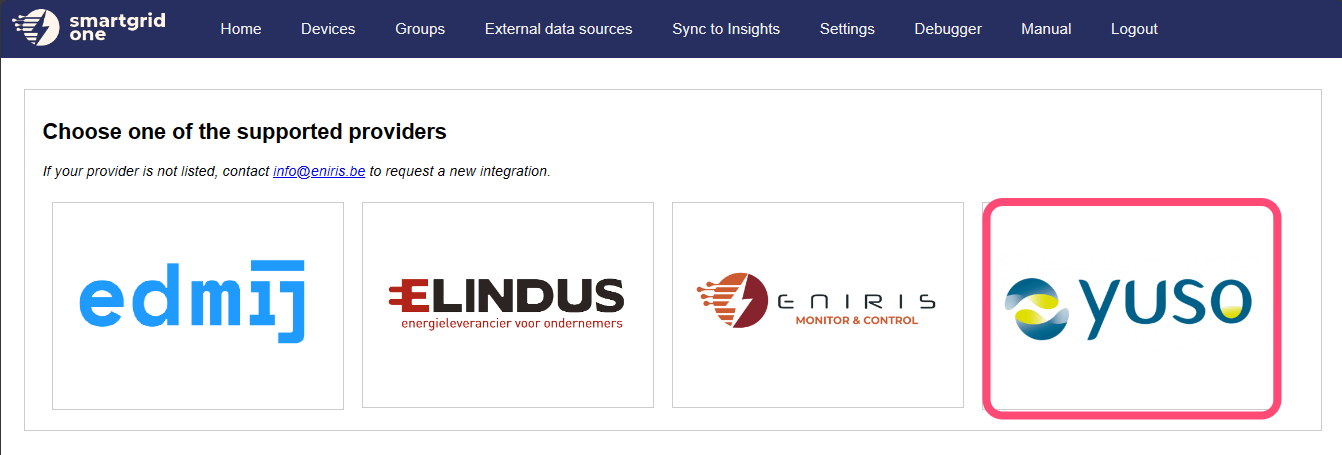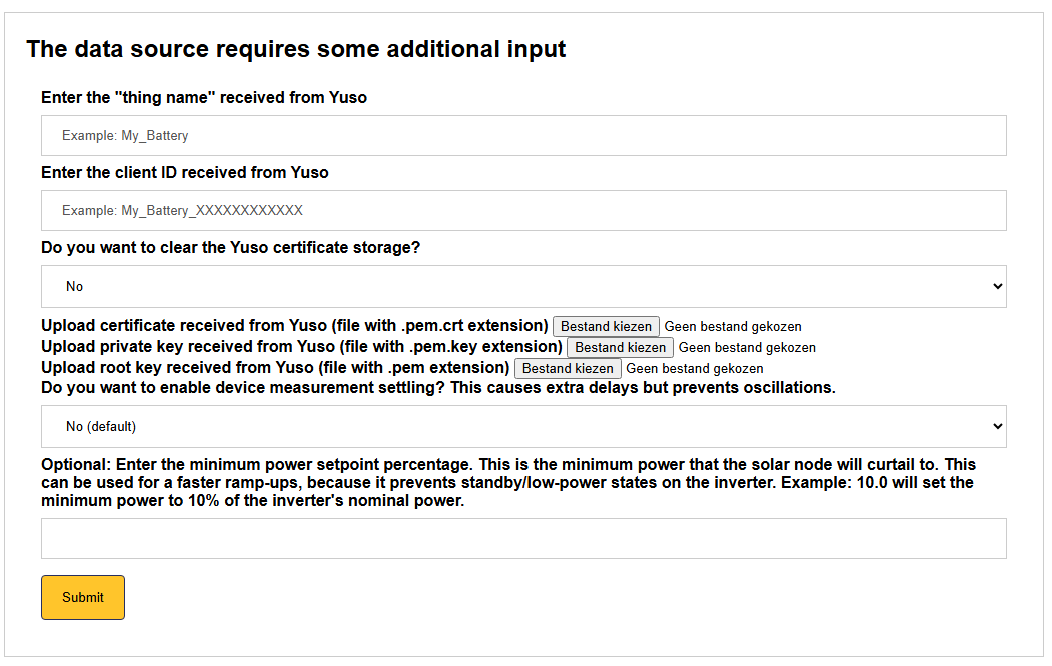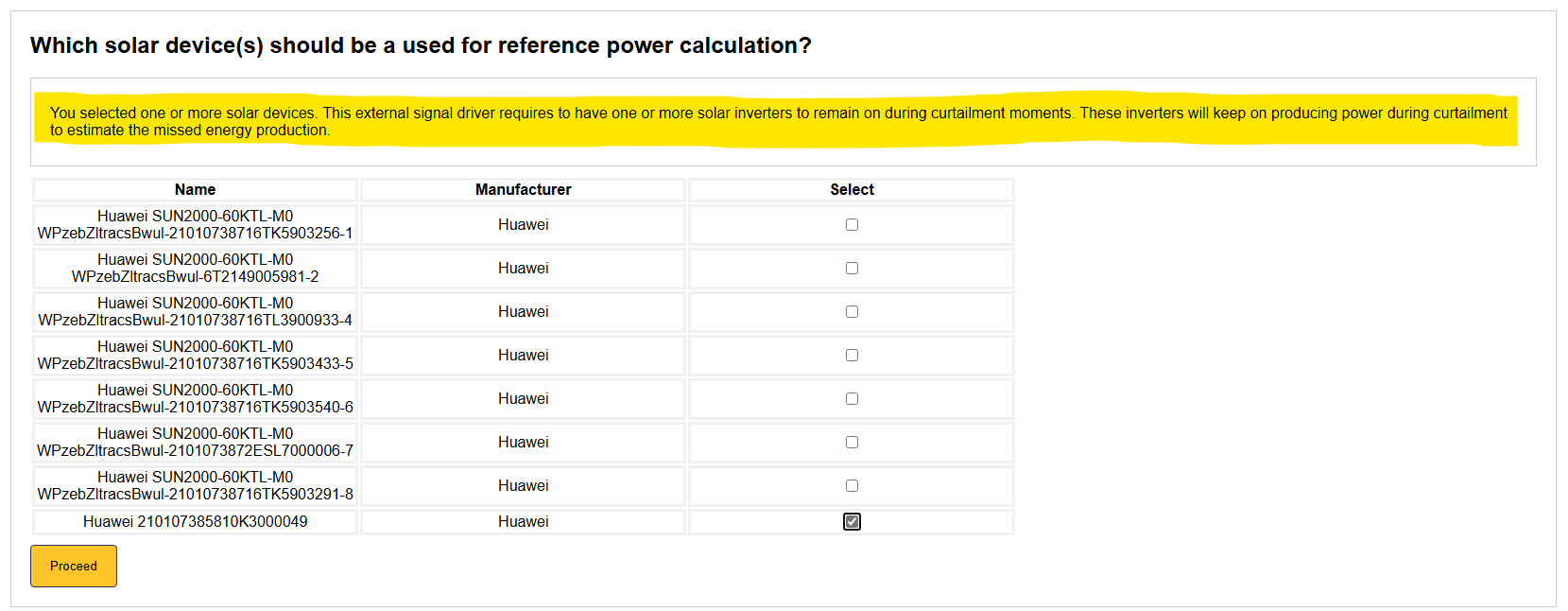يوزو - تقليل الطاقة الشمسية

الأجهزة المدعومة
| Device Type | Variants | م�دعوم |
|---|---|---|
| محولات شمسية | جميعها | ✅ |
| أجهزة التخزين | ❌ | |
| شواحن السيارات الكهربائية |
الدول المدعومة
| Country | مدعوم |
|---|---|
| بلجيكا | ✅ |
| هولندا | ❌ |
البدء
الحصول على ملفات التكوين و'معرف العميل' من يوسو
تُقدم الملفات عادةً في ملف أرشيف مضغوط. قم بفك ضغط الملفات قبل المتابعة.
- شهادة (ملف بامتداد .pem.crt)
- مفتاح خاص (ملف بامتداد .pem.key)
- مفتاح الجذر (ملف بامتداد .pem)
- معرف عميل يوسو (معرف فريد لتثبيتك)
- اسم شيء يوسو
معرف عميل يوسو هو معرف قصير بالشكل التالي:
<اسم التثبيت>_Battery_XXXXXXXXXXXXXXXXXXXX
كل هذه الأشياء ضرورية لتكوين الإشارة الخارجية ليوس في Sofar EMS. يجب أن تكون قد تلقيت هذه الملفات من يوسو. إذا لم تستلمها بعد، يُرجى الاتصال بدعم يوسو.
إضافة أجهزتك
قم بتسجيل الدخول إلى واجهة التكليف وتأكد من إضافة المحولات إلى Sofar EMS.
إضافة الإشارة الخارجية ليوس
أولاً، ابحث عن الإشارة الخارجية ليوس:



قم بإدخال اسم شيء يوسو ومعرف عميل يوسو، وقم بتحميل الملفات التي تلقيتها من يوسو: الشهادة، المفتاح الخاص، ومفتاح الجذر.
استخدم 'نسبة استهداف الطاقة الدنيا' فقط إذا كنت تعاني من وقت تسارع بطيء. بعض المحولات تذهب في وضع السكون عندما يتم تقليلها إلى صفر طاقة، وعندما تُعيد تشغيلها، يستغرق الأمر بعض الوقت للاستيقاظ مرة أخرى. سيضمن هذا الإعداد أن تبقى المحول مستيقظًا دائمًا عن طريق إرسال نقطة استهداف صغيرة، مما يؤدي عادةً إلى وقت تسارع أسرع.

حدد جميع المحولات التي يجب أن تشارك في تقليل الطاقة الشمسية ليوس. إذا كان لديك عدة محولات، يمكنك تحديدها جميعًا دفعة واحدة. مهم: تأكد من أنك تضم أيضًا المحول الذي ترغب في استخدامه لحساب إنتاج الخط الأساسي. لن يتم تقليل هذا المحول، لكنه سيستخدم لحساب إنتاج الخط الأساسي. هذا مهم لتعمل خدمة تقليل الطاقة الشمسية ليوس بشكل صحيح.

الآن حدد المحول(ات) التي ترغب في استخدامها لحساب إنتاج الخط الأساسي. يمكنك اختيار عدة محولات، لكن يجب تحديد محول واحد على الأقل. نوصي باختيار محول واحد هو أصغر محول في موقعك، حيث سيظل 'فقدان التخفيف' في الحد الأدنى. لاحقًا، سنشير إلى هذا المحول باعتباره 'المحول المرجعي(ة)'.

معلومات خلفية
تستخدم يوسو منصة قائمة على السحاب تتيح التواصل مع Sofar EMS. يتم ذلك عبر بروتوكول التواصل MQTT، ومراقبة والتحكم في مجموعة متنوعة من المعلمات.
حساب الإنتاج المُخفَّض و الطاقة الأساسية
لتقدير الإنتاج المُخفَّض، نعين محولا واحدا (من، على سبيل المثال، 10 محولات مشابهة بقدرة 4 كيلووات) كمحول مرجعي، والذي لا يتم تقليله أبدا ويعمل دائما بكامل القدرة، بينما يمكن تقليل الآخرين؛ نفترض أن جميع المحولات يمكن أن تنتج بالشكل مشابه للمحور المرجعي، فإذا كان الناتج 2 كيلووات، نقوم بتكبيره إلى الحجم الإجمالي للنظام. إذا كان حجم النظام الكامل 40 كيلووات وكان المحول المرجعي فقط 3 كيلووات اسمي، فنقوم بضرب 40 / 3 ≈ 13.33 للحصول على خط أساس غير مصحح قدره 26.7 كيلووات. لتحسين الدقة، نطبق عامل تصحيح بناءً على مقارنة لمدة 60 دقيقة تتضمن الإنتاج الفعلي للمحولات المخفضة وما كنا نتوقعه بناءً على المحول المرجعي خلال نفس الفترة — وهذا ينظر في أي أداء أقل أو أكثر من المحول المرجعي مقارنةً بالأسطول. يتم بعد ذلك حساب الإنتاج المُخفَّض على أنه الفارق بين هذا الخط الأساسي المصحح والناتج الفعلي المقاس للمحولات المخفضة. تكون الطاقة الأساسية هي الطاقة التي كان من الممكن أن تنتجها إذا لم يتم تقليلها، مصححة لأداء المحول المرجعي.
أوضاع توجيه يوسو
أساسًا، ترسل يوسو إشارة (وضع توجيه) ليتم تنفيذها من قبل Sofar EMS كل دقيقة. كل دقيقة، تقوم خوارزميات يوسو بحساب أفضل وضع توجيه لتلك البطارية في تلك اللحظة. هناك ثلاثة أوضاع توجيه، وهي متعارضة:
- وضع نشط = وضع الاستعداد.
ترسل يوسو إشارة استعداد إلى Sofar EMS. يسمح Sofar EMS لجميع المحولات بالإنتاج الكامل (بدون تقليل). - وضع نشط = الاكتفاء الذاتي (أو أثناء ضعف الاتصال)
ترسل يوسو إشارة اكتفاء ذاتي إلى Sofar EMS. سيحاول Sofar EMS بعد ذلك تقييد الإنتاج للاستهلاك المحلي، دون تصدير الطاقة إلى الشبكة. وهذا يسمى أيضًا 'عدم التصدير'. - وضع نشط = مباشر
ترسل يوسو نقطة طاقة إلى Sofar EMS، توضح لنا مقدار ما يجب أن تنتجه المحولات. في الممارسة العملية، ومع ذلك، يؤدي ذلك إلى إيقاف تشغيل المحولات.
معلومات حول تجاوز �الإشارة
نحن نحث بشدة على عدم إعداد إشارة خارجية أخرى بجانب إشارة يوس. يمكن لـ Sofar EMS التعامل مع إشارة خارجية واحدة فقط في كل مرة. إذا قمت بإعداد إشارة خارجية أخرى، فسوف تتجاوز إشارة يوس إذا كانت الإشارة الأخرى لها أولوية أعلى. يعني ذلك أن إشارة يوس لن يتم تنفيذها، وأن البطارية لن يتم التحكم فيها بواسطة يوسو.
إذا قررت المتابعة بإعداد إشارة خارجية أخرى، يُرجى أن تكون على علم بما يلي:
- ستقوم Sofar EMS بإرسال سياسة 'الاكتفاء الذاتي' إلى منصة يوس في حالة تجاوز إشارة يوس.
- ستظهر Sofar EMS التحذير التالي في إشارة يوس:
"تحذير: تم العثور على تجاوز من إشارة ذات أولوية أعلى. هذا غير مسموح به من قبل يوسو، ما لم يتم الترتيب خلاف ذلك مع يوسو."
معلومات حول القيام بتقليل الطاقة الشمسية ليوس والتحكم في البطارية في نفس الوقت
يدعم Sofar EMS خدمتين من يوسو:
- تقليل طاقة يوس الشمسية
- التحكم في بطارية يوسو في الوقت الحالي، ليس من الممكن استخدام كلا منتجي Yuso في نفس الوقت. إذا كنت ترغب في استخدام التحكم في بطارية Yuso، تحتاج إلى تعطيل تقييد الطاقة الشمسية Yuso. إذا كنت ترغب في استخدام تقييد الطاقة الشمسية Yuso، تحتاج إلى تعطيل التحكم في بطارية Yuso.
ومع ذلك، من الممكن استخدام أي وضع تحكم محلي (على سبيل المثال، تحسين التكلفة) على الألواح الشمسية والتحكم في بطارية Yuso في نفس الوقت. ولكن كن على دراية بأنه يمكن أن يؤدي ذلك إلى سلوك متناقض من العاكس الشمسي الخاص بك والبطارية: عندما يتم التحكم في الألواح الشمسية بواسطة وضع التحكم المحلي تحسين التكلفة، قد يتم تقييدها في حين يقوم Yuso بتفريغ البطارية.
تعمل Yuso ع�لى إيجاد حل لاستخدام كلا خدمتي Yuso في نفس الوقت. سنقوم بتحديث هذه الصفحة عندما يصبح ذلك ممكنًا.